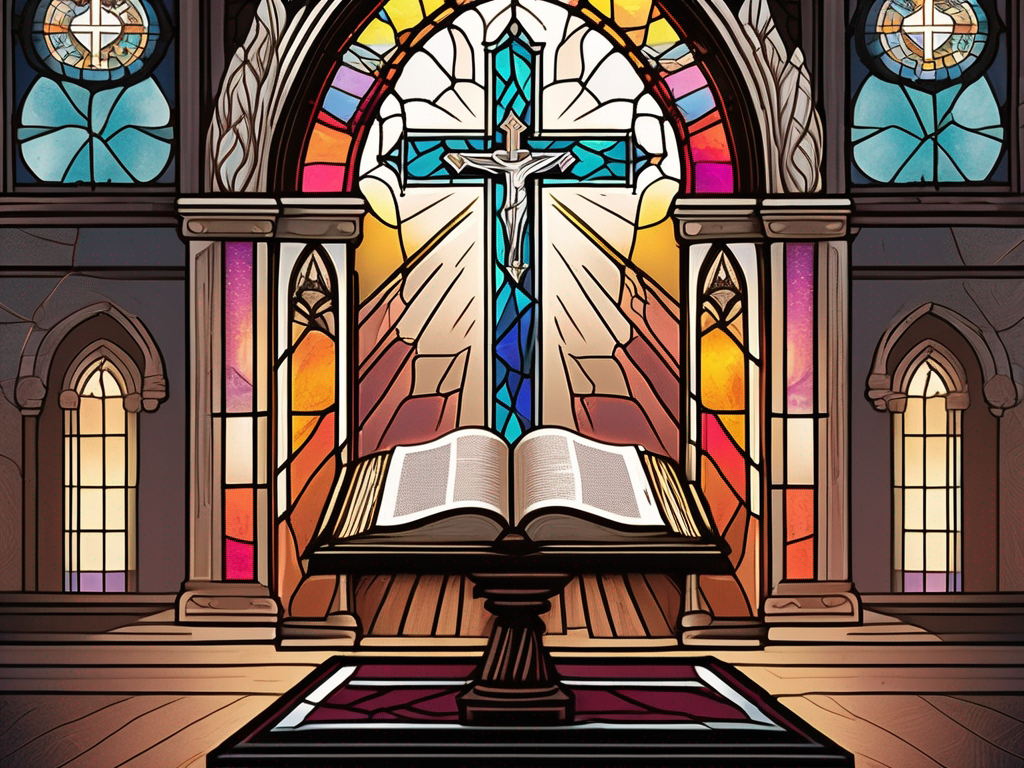The Church of Christ has a rich and fascinating history that spans centuries. This comprehensive overview will take you on a journey through time, exploring the origins, development, and future of this influential religious institution.
Origins and Early Development of the Church of Christ
At the heart of the Church of Christ lies a set of founding principles that have shaped its identity since its inception. These principles emphasize the importance of following the teachings of Jesus Christ, as detailed in the Bible. The early leaders of the Church believed in a return to the simplicity and purity of the early Christian Church.
Key figures such as Alexander Campbell and Barton W. Stone played pivotal roles in the establishment and growth of the Church of Christ. These individuals were instrumental in spreading the message of the Church, attracting followers, and establishing a strong sense of community.
Alexander Campbell, a prominent religious leader and theologian, was born in Ireland in 1788. He immigrated to the United States with his family in 1809 and became deeply involved in the religious landscape of the time. Campbell’s passion for religious reform and his commitment to the principles of the Restoration Movement led him to play a crucial role in the development of the Church of Christ.
Barton W. Stone, another influential figure in the early days of the Church of Christ, was born in Virginia in 1772. He initially pursued a career as a Presbyterian minister but eventually became disillusioned with the denominational divisions and doctrinal disputes within the church. Stone’s desire for unity and a return to the simplicity of early Christianity aligned perfectly with the principles of the Church of Christ.
As the Church of Christ began to gain traction, it experienced significant expansion and growth in the early centuries. The dedication of its members and the emphasis on biblical teachings attracted people from all walks of life, leading to the establishment of congregations in various regions.
One notable aspect of the Church of Christ’s early development was its commitment to the autonomy of individual congregations. Unlike many other religious denominations, the Church of Christ does not have a central governing body or hierarchy. Each congregation is autonomous and makes its own decisions regarding matters of faith and practice. This emphasis on local autonomy has allowed the Church of Christ to adapt and thrive in different cultural contexts.
Another key factor in the Church of Christ’s growth was its emphasis on the importance of baptism for the forgiveness of sins. The early leaders of the Church believed in the necessity of baptism by immersion as a response to the gospel message. This emphasis on baptism as a crucial step in the journey of faith attracted many individuals seeking a deeper spiritual experience.
Throughout its early development, the Church of Christ faced challenges and opposition from various quarters. Some criticized its rejection of denominationalism and its insistence on a return to the simplicity of the early Christian Church. Others questioned its theological positions, particularly its views on baptism and the role of women in the church. However, despite these challenges, the Church of Christ continued to grow and establish a strong presence in communities across the United States and beyond.
Today, the Church of Christ remains committed to its founding principles and continues to emphasize the importance of following the teachings of Jesus Christ as revealed in the Bible. Its dedication to biblical authority, simplicity of worship, and the autonomy of individual congregations sets it apart from many other religious denominations. As the Church of Christ looks to the future, it seeks to carry forward its rich history and make a positive impact in the lives of its members and the communities it serves.
The Church of Christ during the Middle Ages
During the Middle Ages, the Church of Christ faced numerous challenges and controversies. Its role in society was both influential and contentious. The Church sought to guide individuals spiritually while maintaining a stronghold on political power. This led to clashes with secular authorities and a struggle for control over religious doctrine.
Theological developments within the Church of Christ during this period also played a significant role in shaping its identity. The Church grappled with questions of faith, the nature of God, and the role of religious rituals in salvation. These debates and discussions laid the groundwork for the theological landscape of the Church in subsequent centuries.
One of the key challenges the Church faced during the Middle Ages was the rise of heretical movements. These movements, such as the Cathars and the Waldensians, posed a threat to the authority of the Church and its teachings. The Church responded by launching inquisitions and crusades to suppress these dissenting voices and maintain its control over religious orthodoxy.
Furthermore, the Church of Christ played a crucial role in the education and intellectual life of the Middle Ages. Monastic orders, such as the Benedictines and the Cistercians, were centers of learning and scholarship. Monasteries served as repositories of knowledge, preserving ancient texts and producing new works through transcription and illumination. The Church also established universities, such as the University of Paris and the University of Bologna, where scholars studied theology, philosophy, and other disciplines.
The Church’s influence extended beyond the spiritual and intellectual realms. It also played a significant role in the social and economic life of medieval society. The Church owned vast amounts of land and controlled a substantial portion of the economy. It collected tithes and other forms of taxation, which provided the Church with considerable wealth and power. This wealth was used to fund the construction of magnificent cathedrals and monastic buildings, which served as symbols of the Church’s grandeur and authority.
Despite the challenges it faced, the Church of Christ managed to persevere and maintain a strong presence throughout the Middle Ages. Its influence in society continued to grow, and its teachings impacted the lives of countless individuals. The Church provided a sense of stability and community in an era marked by political turmoil and social upheaval. It offered solace and hope to the masses, promising salvation and eternal life.
The Church of Christ in the Modern Era
The modern era marked a time of significant social changes, and the Church of Christ was not immune to these shifts. It faced the daunting task of adapting its teachings to the evolving values and beliefs of the society it served. The Church responded by addressing social issues through its teachings, advocating for justice, and promoting compassion and inclusivity.
The Church of Christ extended its reach beyond national borders, becoming a global religious institution. Its teachings spread to different continents, and congregations were established in diverse cultures and communities. This expansion allowed the Church to connect with individuals from various backgrounds, fostering a sense of unity and shared purpose.
As the Church of Christ expanded its influence globally, it encountered unique challenges and opportunities. In Africa, for example, the Church played a crucial role in addressing issues such as poverty, disease, and political instability. Missionaries and volunteers from the Church worked tirelessly to provide aid and support to those in need, establishing schools, healthcare facilities, and community centers.
In Asia, the Church of Christ found itself in a region rich with diverse religious traditions. It engaged in interfaith dialogue, seeking common ground and promoting mutual understanding. Through these efforts, the Church fostered a spirit of religious tolerance and cooperation, encouraging individuals to embrace their own faith while respecting the beliefs of others.
In Europe, the Church of Christ faced the challenge of reaching out to a society that was becoming increasingly secularized. It responded by emphasizing the relevance of spirituality in the modern world and offering a welcoming space for individuals seeking a deeper connection with their faith. The Church organized retreats, conferences, and workshops that explored the intersection of spirituality and contemporary issues, providing a platform for meaningful discussions and personal growth.
Today, the Church of Christ continues to uphold its core beliefs and practices while adapting to the realities of the 21st century. It remains dedicated to nurturing spiritual growth, promoting social justice, and providing support to its members and the wider community.
Within its congregations, the Church of Christ encourages active participation and engagement. It offers various ministries and programs tailored to different age groups and interests, ensuring that every member has the opportunity to contribute and find their place within the community. From youth groups focused on leadership development to outreach initiatives aimed at serving the homeless, the Church provides a multitude of avenues for individuals to live out their faith in practical ways.
Furthermore, the Church of Christ recognizes the importance of technology in the modern era. It has embraced digital platforms and social media to connect with its members and reach out to a wider audience. Online sermons, virtual prayer groups, and interactive Bible study sessions are just some of the ways in which the Church utilizes technology to enhance spiritual growth and foster community engagement.
In an ever-changing world, the Church of Christ remains committed to adapting its teachings and practices to meet the needs of its members and society at large. It continues to be a beacon of hope, offering guidance, support, and a sense of belonging to all who seek it.
The Future of the Church of Christ
As the Church of Christ looks to the future, it recognizes the need to adapt to a changing world. The challenges ahead are significant, with shifting demographics, technological advancements, and evolving societal norms. However, the Church is committed to ensuring that its teachings remain relevant and resonate with future generations.
The role of the Church in the 21st century goes beyond religious gatherings. It encompasses a broader mission to address social issues, promote equality, and engage with the wider community. The Church of Christ seeks to be a positive force for change, inspiring individuals to make a difference in their communities and the world.
One of the key ways the Church is preparing for the future is by embracing technology. In an increasingly digital world, the Church recognizes the importance of utilizing online platforms to reach a wider audience. Through live-streamed services, podcasts, and social media engagement, the Church of Christ aims to connect with individuals who may not have previously been exposed to its teachings. This digital presence also allows for greater accessibility, ensuring that anyone, regardless of their location, can participate in the Church’s activities and learn about its beliefs.
Another area of focus for the Church of Christ is interfaith dialogue. Recognizing the importance of fostering understanding and cooperation among different religious communities, the Church actively seeks opportunities to engage in meaningful conversations with individuals of diverse faith backgrounds. By promoting dialogue and mutual respect, the Church hopes to contribute to a more harmonious and inclusive society.
Looking ahead, the Church of Christ has a clear vision for the future. It envisions a world where love, understanding, and compassion guide interactions between individuals. The Church seeks to be a catalyst for positive change, encouraging its members to live out their faith by serving others and making a tangible impact on society.
One of the ways the Church plans to achieve this vision is through community outreach programs. These programs aim to address the needs of the most vulnerable members of society, such as the homeless, the elderly, and the marginalized. By providing practical support, such as food, shelter, and healthcare, the Church hopes to demonstrate the transformative power of love and compassion.
Furthermore, the Church of Christ recognizes the importance of nurturing the next generation of leaders. It invests in programs and initiatives that empower young people to develop their skills, talents, and faith. By equipping them with the necessary tools and resources, the Church aims to create a strong and vibrant community that can continue to thrive in the future.
In Conclusion
The history of the Church of Christ is a tapestry of faith, growth, and adaptation. From its origins rooted in biblical teachings to its present-day global presence, the Church has navigated through centuries of challenges and changes. As it looks to the future, the Church remains steadfast in its commitment to spreading the message of Jesus Christ and making a meaningful difference in the world.












